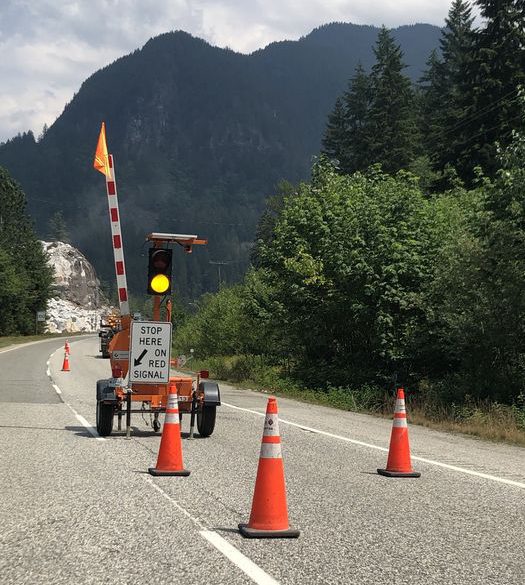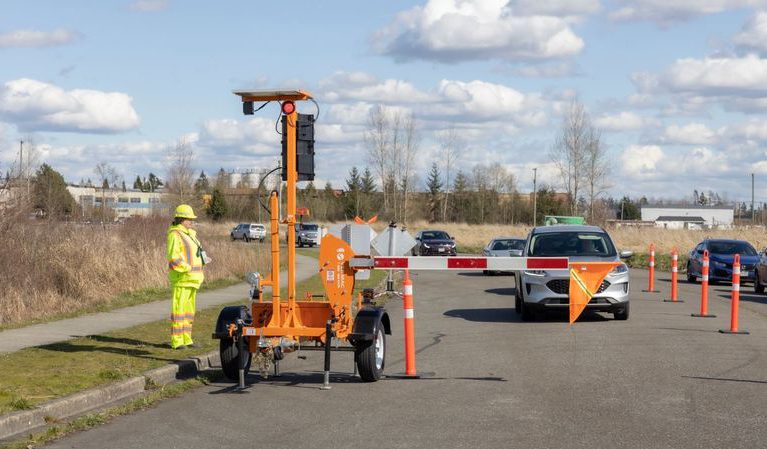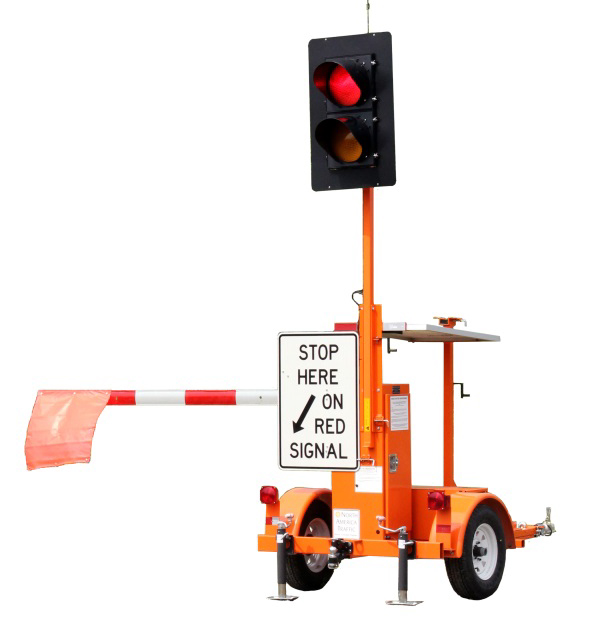
It’s safe to say: Automated Flagger Assistance Devices (AFAD) are only going to become more common on BC roadways. Not only do they provide effective traffic management, they also keep traffic controllers out of harms way.
Problem is, some drivers may not be familiar with the way AFADs work, which is causing confusion at some work zones. We’re here to explain what AFADs are, how they operate, and why they are important.
How to Spot an AFAD
AFADs are portable, remotely operated temporary traffic control equipment with high visibility signage. They feature red and yellow traffic lights and a gate-arm with a fluorescent orange or red flag that moves up and down, extending into the travel lane. The device can only be used on two-lane, two-way roadways and on multilane roadways that have been reduced to one lane. They are used for single lane alternating traffic or intermittent stoppage situations.
AFADs have several benefits. They are:
- portable,
- easy to set up,
- small enough to be used in areas where the road has narrow shoulders.
And, most importantly, they are highly visible to drivers. Studies in the US show that AFADs lower drivers’ approach speeds and encourage them to stop further back compared to human flaggers positioned on the roadway.
If you really want to get into the nitty-gritty requirement details for AFADs, they are available in Section 4.7.3 of the Traffic Management Manual for Work on Roadways.
And you can get a closer look at the devices in this Cone Zone campaign video, which explores AFADs and other temporary traffic control devices:
Roadway Robots? Well, Not Quite…
AFADs do not operate on their own; they require at least one traffic control person (TCP) with a remote control device, who can position themselves well away from moving traffic. Think of an AFAD as an extension of the TCP’s arm.
For work zones with greater distance between traffic queues, two people are required because they must have an unobstructed view of their flagging device.
There are multiple configurations possible, so don’t be surprised if you see any of the following:
- Two Traffic Control People:
- One person operates each AFAD at either end of the work activity area; or
- One person operates an AFAD at one end of the work activity area and the second person controls traffic with a paddle at the other end.
- Single Traffic Control Person:
- One person is positioned in a central location (where they can see both AFADs), simultaneously operating two AFADs that are positioned at either end of the work activity area; or
- One person operates a single AFAD that is positioned at one end of the work activity area while also controlling traffic with a paddle at the opposite end.

What the Colours Mean — Red is Not a Glitch!
Like we said earlier, we’ve been receiving reports of drivers being confused or ignoring AFADs. We’ve had instances of people driving around the closed gate, and even busting right through the gate, which is extremely dangerous considering AFADs are usually used to control single lane alternating traffic.
Remember: AFADs are operated by traffic control people onsite. If you are waiting in front of an AFAD with its gate down and red light shining, and there is no oncoming traffic, do NOT assume it is malfunctioning – do NOT drive ahead. Wait until the red light switches to yellow and the gate rises – only then is it safe.

AFADs are there to make traffic control safer for workers and more effective for travellers. And with so many benefits to using them, you’ll be seeing more of them on the roads in the future. Please respect them in the Cone Zone, and drive safely.
We have many more stories about traffic control and roadside worker safety. Check them out!
>> How to Help Volunteer Firefighters Help Others on BC Highways
>> Why Slow Down if No Workers at Construction Site?
We have a lot of them in Chilliwack especially with the pipeline going thru. I used to be a flagger years ago in Vancouver and people weren’t very nice to us then and I’m sure they’re worse now. I’m all for keeping workers safe . I think they are just great.
Thanks for your comment, Debbie. We appreciate it, and agree that keeping workers safe is a top priority.
AFADs will save lives and numerous serious injuries. Did you know; traffic control is one of the top 5% of jobs that result in injury; twice as hazardous as excavation or concrete forming work activity.
Thanks for sharing with us, JerrylAm!
These devices are great, not suitable for a lot of area’s. Still a lot of drivers not used to these new devices, why dose not the MOTI do a public commercial, or invite news crews for a mock demonstration to get public awareness out? The BC public are used to TCP’s and now you (WorksSafeBC) is taking them away, and not educating the public no these devices. Its good putting this out on Social Media, but I feel its not enough as its a small sample group who really see this.
Thanks for your feedback, Ben. We have shared your suggestion with our Cone Zone Alliance members for consideration. Safe travels and thanks again.
What a joke!
I have been a TCP for 23 years and NEVER once had a issue.
Your big mistake was making the TCP stand on the white line get back in the yellow line so the traffic can see you and you can see your traffic, they blend in with the flashing lights and the truck!
Most flaggers today are to lazy to get out of the vehicle and just stand the paddle in a cone leaving it on slow, that just frosts me!
Can you imagine these idiots trying to back up that little trailer?
You guys need to re-think this whole idea and have surprise inspections on these companies
Hello, Laurie – thanks for sharing your concerns with us here. We have shared your feedback with our staff in the area for their review.
I’ve seen lot’s of these around Hope, BC. Due to pipeline project. I am red green colorblind and they are confusing!
Thanks for your comment, Mannie. We shared your comment with our traffic engineering group who advised that the positioning of the light can be used to determine the colour of the signal. The top is always “RED” and the bottom is always “YELLOW”. Hope this information is helpful!
Wonder how they work when the traffic flow only has short gaps? Unlike a normal traffic light there is no amber signal warning they are about to change. I guess that means they won’t be practical on busy highways (where flaggers are at most risk). N.B I used to work as a flagger on Highway 1 around Revelstoke and often had to cut off a line of traffic because otherwise the other direction would be waiting forever for a gap in my traffic!
Hi Nick – thanks for your comment. Our traffic engineers let us know that the devices are not used in isolation, but with other traffic control devices that help drivers know something is up ahead. They also have a gate which stops and releases traffic.
That doesn’t answer how you get traffic to stop when there are only very short gaps between vehicles.
If a flagger needs to stop a steady stream of traffic, part way, for a reason like you described, then after they give the AFAD the signal to stop, the light changes from a flashing amber to a solid amber – like you would see when your green light is about to change colour. Then the light turns to red, it waits a second or two and then the gate arm slowly drops.
Thanks for providing further details and perspective, Troy!
They go from flashing amber, to solid amber, then to red. There is a significant delay (3 sec-ish) between flashing to solid then to red. Another pause (3sec-ish) before the gate arm lowers down.
I have used AFADs on highway, and in the city. While there is a learning curve for the general population, the concept shouldn’t be that hard to grasp. Having the gate arm is awesome, as I also run Portable Traffic Signals/Lights and when the driver can see that there is no oncoming traffic they tend to run the red lights.
oops i should have read on, looks like i already commented on this haha
😉